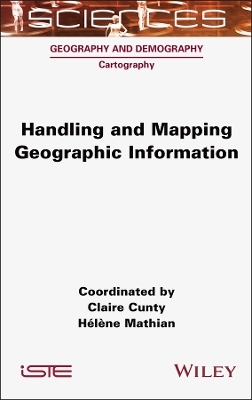
Handling and Mapping Geographic Information
Iste Ltd (Verlag)
978-1-78945-161-0 (ISBN)
- Noch nicht erschienen
- Versandkostenfrei
- Auch auf Rechnung
- Artikel merken
Handling and Mapping Geographic Information presents a wide range of operations based on a variety of examples. Each chapter adopts a different approach, explaining the methodological choices made in relation to the theme and the pursued objective.
This approach, encompassing the entire map production process, will enable all readers, whether students, researchers, teachers or planners, to understand the multiple roles that maps can play in the analysis of geographical data.
Claire Cunty is a lecturer and researcher in geography at the Université Lumière Lyon 2, France, and a member of the Environnement Ville Société research unit. Her research focuses on the design and use of geovisualization interfaces for spatiotemporal information and on digital approaches to sensitive maps. She is also part of the supervisory team for the Master’s program in Digital Geographies at Lyon 2 and SaintEtienne Universities. Hélène Mathian is a CNRS engineer in spatial analysis methods at the Environnement Ville Société research unit, France. Her work integrates the spatial dimension into statistical processing and models, and uses geovisualization as a means of exploring geographic data and spatial dynamics. She is also part of the supervisory team for the Master’s program in Digital Geographies at Lyon 2 and Saint-Etienne Universities.
Foreword xi
Colette CAUVIN-REYMOND
Introduction xvii
Claire CUNTY and Hélène MATHIAN
Chapter 1. Exploring Statistical Relationships with Maps and Charts 1
Jean-Benoît BOURON, Claire CUNTY, Hélène MATHIAN and Myriam BARON
1.1. Introduction 1
1.2. Mapping the world: which world? what data? 4
1.3. Exploring data and relationships with maps and charts 11
1.4. Describing statistical relationships between several variables 18
1.5. Conclusion 25
1.6. References 26
Chapter 2. Heterogeneous Data Integration and Geoweb Cartographic Representations 29
Marianne GUÉROIS and Malika MADELIN
2.1. Introduction 29
2.2. New data: from production to visualization 32
2.3. New data, traditional data: why and how to integrate them? 45
2.4. Conclusion 59
2.5. References 61
Chapter 3. Environmental Data and Cartographic Objects 65
Étienne COSSART
3.1. Introduction 65
3.2. Building cartographic objects: deconstructing to reconstruct. 67
3.3. Dealing with disparate and incomplete data: examples from environmental geography 74
3.4. Conclusion 86
3.5. References 87
Chapter 4. Mapping and Identifying Geographic Configurations: The Example of Segregation 89
Sylvestre DUROUDIER
4.1. Introduction 89
4.2. Mapping: rendering spatial configurations visible or invisible 91
4.3. How to measure a phenomenon so as to reveal its forms 104
4.4. Capturing spatial forms using dynamic approaches 116
4.5. Conclusion 125
4.6. References 126
Chapter 5. Map and Statistical Model to Explore Spatial Heterogeneity 131
Mohamed HILAL and Julie LE GALLO
5.1. Introduction 131
5.2. From raw open-source data to statistical data 133
5.3. Preliminary explorations of spatial variations 139
5.4. Analyzing relationships statistically and rendering a map 149
5.5. Conclusion 168
5.6. References 169
Chapter 6. Mapping Time 173
Claire CUNTY and Hélène MATHIAN
6.1. Introduction 173
6.2. Formalization 175
6.3. Monitoring territorial changes 184
6.4. Representing phenomena associated with movement 191
6.5. Representing temporality 197
6.6. Conclusion 206
6.7. References 209
Chapter 7. Cartograms, Anamorphic Maps: Transformed Territories 217
Anne-Christine BRONNER
7.1. Introduction 217
7.2. Cartograms to represent count data associated with areal units 219
7.3. Anamorphic map for the representation of space-time 234
7.4. Anamorphic maps, cartograms: cross-cutting reflections on common principles and reading difficulties 247
7.5. Conclusion 251
7.6. References 252
Chapter 8. Exploration, Aggregation and Spatiotemporal Visualization of Big Data 257
Claude GRASLAND
8.1. Introduction 257
8.2. Defining the object of study and selecting the corpus 259
8.3. Crossing the "who" and "what" dimensions 264
8.4. Crossing the "who", "what" and "when" dimensions 266
8.5. Crossing the "who", "what" and "where" dimensions 270
8.6. Graphs to represent co-location relationships 275
8.7. Conclusion 282
8.8. References 284
Conclusion 287
Claire CUNTY and Hélène MATHIAN
List of Authors 291
Index 293
| Erscheint lt. Verlag | 9.1.2025 |
|---|---|
| Reihe/Serie | ISTE Consignment |
| Verlagsort | London |
| Sprache | englisch |
| Themenwelt | Naturwissenschaften ► Geowissenschaften ► Geografie / Kartografie |
| ISBN-10 | 1-78945-161-2 / 1789451612 |
| ISBN-13 | 978-1-78945-161-0 / 9781789451610 |
| Zustand | Neuware |
| Informationen gemäß Produktsicherheitsverordnung (GPSR) | |
| Haben Sie eine Frage zum Produkt? |
aus dem Bereich


